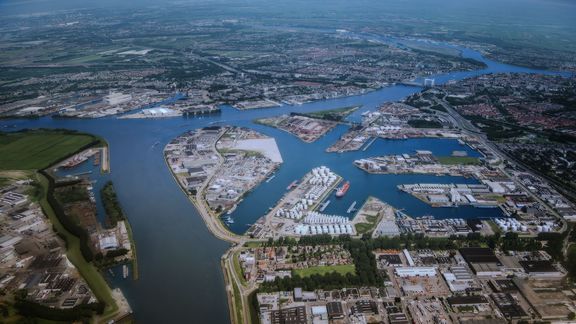
Dordrecht Inland Seaport
Dordrecht Inland Seaport is the most landward sea port in the Netherlands and offers space for growth, innovation and sustainable development. Its strategic situation on the intersection of the foreland and hinterland make Dordrecht’s port area a smart choice of location for companies working in maritime manufacturing, logistics services and bulk handling.
5 reasons to establish your business in Dordrecht Inland Seaport
Excellent accessibility for all vessels
Its depth of almost 10 metres means that the port is also accessible to sea-going vessels with a draught of up to 9.45 metres. Inland vessels and sea-going vessels can reach Dordrecht from the North Sea and the terminals in the Rotterdam Maasvlakte in around three hours. The Oude Maas is connected with the Waal and Rhine via the Beneden-Merwede, which means that the port is also connected with the German border. The Port of Moerdijk is also accessible to inland shipping via Hollands Diep and Antwerp is also accessible by water.
Located on a multimodal intersection
Dordrecht Inland Seaport lies directly on the A16 motorway, along the Rotterdam-Breda-Tilburg-Eindhoven-Venlo and Rotterdam - Antwerp logistics axis. The port is also situated favourably with respect to the N3, which connects the A16 with the A15 at Papendrecht. The inland location has an advantage that maritime cargo can avoid the traffic dense A15. The area also offers good rail connections. There is a trunk line that is connected to Dordrecht train station and the largest shunting yard in the Netherlands: Kijfhoek. This enables the supply and distribution of general cargo, containers and bulk via rail.
Cluster for the maritime manufacturing industry
For producers of maritime components or suppliers of maritime products, a location in the Port of Dordrecht is a smart choice. Dordrecht is part of the Maritime and Smart Industry Top Region Drecht Cities. This collaborative venture includes the municipalities of Alblasserdam, Sliedrecht, Hendrik-Ido-Ambacht, Papendrecht and Zwijndrecht. Together these places form the most important cluster for the maritime manufacturing industry in the Netherlands. Over 850 maritime companies are located here, including Boskalis, Royal IHC, Damen Shipyards, Heerema and Oceanco.Dordrecht Inland Seaport is also part of the Westelijke Dordtse Oever (WDO)(in Dutch), an agglomeration of industrial sites that is home to over 900 companies.
Close to the city, close to personnel
The Port of Dordrecht is located next to the city of Dordrecht. This means that city provisions such as shopping centres, petrol stations, meeting and training locations, restaurants and other catering establishments are close by. With almost 120,000 residents, a large, motivated labour pool is available in the immediate vicinity. Shipbuilding and the maritime industry have always played an important role in the region. Some 4,000 people already work in the port. They go to work every day by bike, car, scooter or public transport. Personnel from outside the city can reach the port by train and bus or by car.
Greenery and investments in public space result in an attractive business climate
Dordrecht Inland Seaport is not only unique in terms of logistics options and location opportunities. It also offers an abundance of greenery and parks, and its unique atmosphere is defined by the nearby water. Over the past few years, the Port of Rotterdam Authority has made substantial investments in the local public space. Green areas, parking facilities and traffic infrastructure have been upgraded, and Dordrecht’s port basins have been dredged to a greater depth. In addition, the Port Authority and its partners have entered into a covenant regarding the improved enforcement of local regulations by BOA Rotterdam and Stadsbeheer Dordrecht. Public transport connections with Dordrecht Central Station have been substantially improved. The port area has also gained two new business investment zones, BIZ Louterbloemen and BIZ Krabbepolder. Their members have taken a number of collective measures to improve safety in the port area. These include a park management programme with barrier systems, CCT monitoring and surveillance. Over the next few years, the Port Authority will focus on [optimising the local business climate, building up a clean energy cluster and stimulating employment in the area.
With a local water depth of almost 10 metres, the port area is also accessible for sea-going vessels and bulk carriers. The port, including the port basins, covers an area of 290 hectares. Approximately 3 hectares of this land (with or without berths) are available for immediate issue as ground lease. The plots are issued by the Port of Rotterdam Authority. There are also several business premises and warehouses for rent and for sale.
Wilhelminahaven future proof
With an investment of 3.5 million, the Port of Rotterdam Authority made the Wilhelminahaven future-proof. As a result, the port can now meet the rising demand for handling capacity. Mooring buoys have been replaced, and the jetties, mooring posts and barge areas have been renewed. This will increase the handling capacity, make optimal use of the nautical space and enhance safety for all users.
Increased handling capacity
They current mooring buoys are replaced by five new, certified mooring buoys with a maximum tensile strength of 200 tonnes. The new buoy configuration will increase the port’s board-board handling capacity as well as make it possible for larger vessels to put through a higher volume of cargo simultaneously. The new buoy berth was designed with a sharp eye for future requirements.
Development vision
As the party responsible for operating Dordrecht Inland Seaport, the Port of Rotterdam Authority has drawn up a long-term vision for the area. Besides the expansion of port-related activities in the area, this vision pays special attention to the encouragement of private investments, sustainable developments and strengthening the regional employment market. Over the next few years, the Port Authority will focus on optimising the local business climate, building up a clean energy cluster and further developing the area’s social infrastructure.
Vital and sustainable seaport area
The underlying objective is to visibly and successfully develop Dordrecht Inland Seaport into a vital and sustainable sea port area that forms an attractive business location for port-related companies and a pleasant environment for the local workforce. To this end, the Port Authority will be making a targeted investment in the following activities:
- Strengthen the area’s existing port-related and sea port-related business activity;
- Raise productivity at the terminals and make optimum use of the available space;
- Where required, relocate non-port-related business activity to industrial sites in the vicinity of the port – the Dordtse Kil estates, for example;
- Expand the port’s portfolio with a clear focus on the handling of dry bulk, liquid bulk and breakbulk, logistics and distribution and maritime manufacturing;
- Improve the area’s visual quality by investing in public space, including public green space and local infrastructure;
- Strengthen the port area’s relationship with nearby sites in the Westelijke Dordtse Oever (WDO) area and in the city of Dordrecht by improving accessibility, among other measures;
- Determine the feasibility of the joint development of a Clean Energy Hub on Duivelseiland in partnership with the private sector.

Download
More information? Contact:
